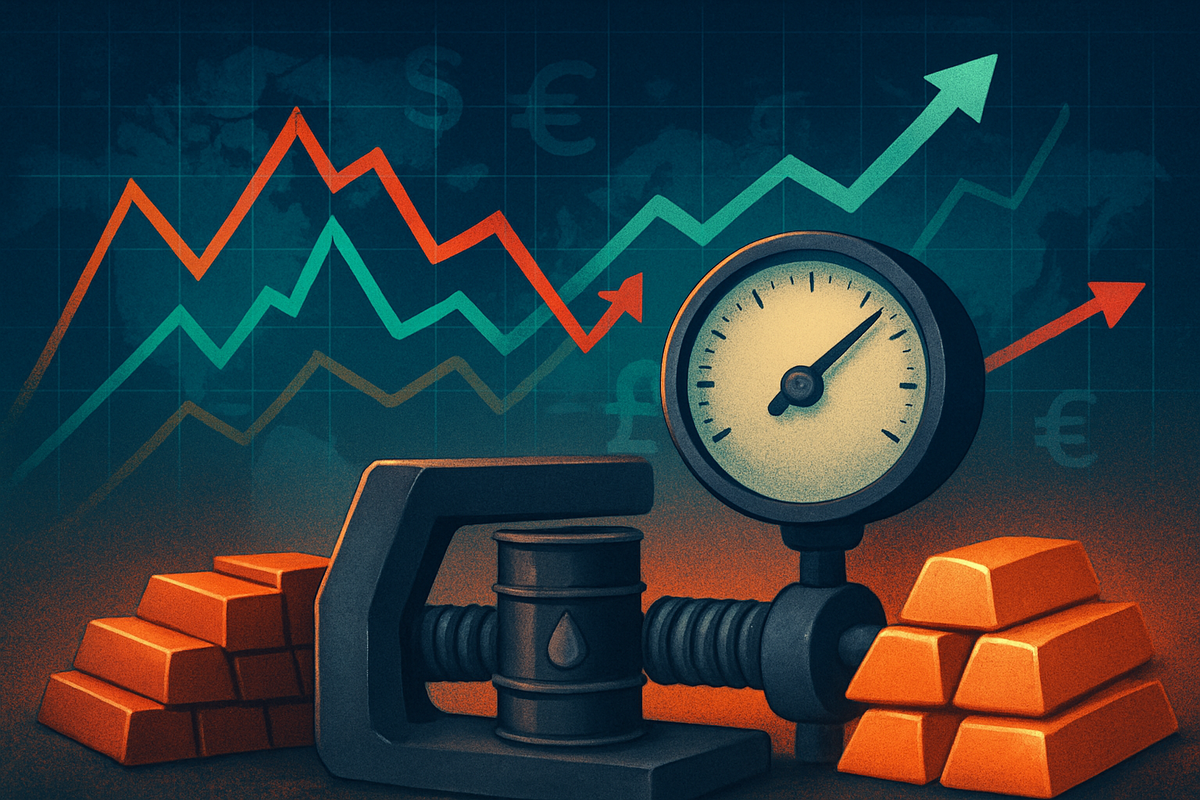
The global financial landscape on November 14, 2025, is defined by a potent and challenging combination: persistent exchange rate volatility clashing with a mixed but often elevated trajectory of commodity prices. This intricate interplay is generating significant economic pressure across virtually all sectors, forcing businesses and consumers alike to grapple with unpredictable costs and uncertain market conditions. The immediate implication is a heightened sense of instability, where the cost of doing business and the purchasing power of consumers are constantly under siege from forces largely outside their control.
This dual economic phenomenon creates a complex web of challenges, from inflationary pressures that erode savings and corporate margins to increased risks in international trade and investment. Central banks and governments are facing a delicate balancing act, attempting to curb inflation while simultaneously navigating uneven economic growth and geopolitical uncertainties. The coming months are poised to test the resilience of economies worldwide as they adapt to these formidable headwinds.
The Unfolding Economic Squeeze: A Detailed Look
The current economic squeeze is a culmination of several intertwined factors that have been developing throughout 2025. Exchange rate volatility has been a prominent feature, driven by divergent monetary policies among major central banks. While the US Federal Reserve has largely maintained higher interest rates, influencing a stronger US Dollar, other central banks like the European Central Bank (ECB) have held steady, and some, such as the Reserve Bank of New Zealand and the Bank of Canada, have implemented rate cuts. These policy divergences create significant interest rate differentials, directly impacting currency valuations and leading to substantial fluctuations in major currency pairs. For instance, the EUR/USD pair saw a 14% movement from just over 1.02 in January to nearly 1.16 by the end of October, while the GBP/USD also experienced approximate 17% ranges in its movements.
Adding to this currency turbulence are persistent geopolitical risks and escalating trade tensions. Ongoing conflicts, the implementation of significant tariffs—such as the 50% US tariff on copper imports effective August 2025—and political uncertainties surrounding upcoming elections in major economies (Europe and the US in 2025-2026) have all contributed to market unsettlement. Furthermore, uneven global economic growth, particularly a slowdown in China, has introduced uncertainty and influenced capital flows, further exacerbating currency instability. Underlying these factors is the broader trend of monetary debasement, where central bank balance sheet expansions and deficit-funded government spending systematically erode currency purchasing power.
Simultaneously, commodity markets present a mixed but impactful picture. While the overall aggregate price movements, as measured by the S&P Goldman Sachs Commodity Index, are projected to decline slightly in 2025 and 2026, specific commodities have seen significant gains. Metallurgical coal, crude oil, and aluminum each posted solid gains of around 5% in October, with copper surging 10% following the US tariff announcement. Precious metals like gold and silver have shown considerable strength throughout 2025, driven by safe-haven demand amidst geopolitical uncertainty and currency weakness, with silver surging 8.5% in a week and gold rising nearly 4%. Conversely, some segments of the crude oil market saw declines, and industrial raw materials are projected to trend downward. This divergence underscores the complex supply and demand dynamics, geopolitical influences, and the impact of underinvestment in mining and energy sectors in previous years, which could lead to tighter supply in the medium term.
The initial market reactions to this dual pressure have been characterized by increased hedging activities by businesses, a flight to safety in assets like gold, and a general recalibration of investment strategies. Companies engaged in international trade are particularly vulnerable, facing direct impacts on their margins and cash flow. Importers struggle with rising costs when their domestic currency weakens, making cross-border supplier payments more expensive, while exporters may see reduced returns. This environment necessitates robust currency risk management and forces businesses to model potential currency movements of 5-10% to align operational strategy with financial forecasting.
Companies Navigating the Crosscurrents: Winners and Losers
The intricate dance between exchange rate volatility and rising commodity prices creates a clear divide between potential winners and losers in the corporate landscape. Companies with strong exposure to commodity extraction and those that benefit from safe-haven demand are likely to fare better, while businesses heavily reliant on imported raw materials or those with significant international operations lacking robust hedging strategies will face considerable headwinds.
Potential Winners:
- Mining Companies (especially Copper and Precious Metals): Companies like BHP Group (ASX: BHP), Rio Tinto (ASX: RIO), and Freeport-McMoRan (NYSE: FCX), particularly those involved in copper mining, stand to benefit significantly from rising copper prices, exacerbated by tariffs like the US 50% tariff. Similarly, gold and silver miners such such as Barrick Gold (NYSE: GOLD) and Newmont Corporation (NYSE: NEM) are poised for gains as precious metals continue to attract safe-haven investment amidst currency debasement and geopolitical uncertainty.
- Energy Producers (Natural Gas): Companies with strong natural gas assets, like ExxonMobil (NYSE: XOM) or Shell plc (LON: SHEL), could see increased profitability due to strong demand from Europe and Asia. While crude oil has seen mixed performance, companies with diversified energy portfolios might still find opportunities.
- Domestic Manufacturers with Localized Supply Chains: Businesses that have successfully localized their supply chains and reduced reliance on imported raw materials could gain a competitive advantage. They would be less exposed to currency fluctuations affecting import costs and potentially benefit from comparatively stable input prices.
- Companies with Robust Hedging Strategies: Businesses that have proactively implemented sophisticated currency and commodity hedging strategies, such as major multinational corporations with dedicated treasury functions, can mitigate risks and protect their margins, potentially outperforming less prepared competitors.
Potential Losers:
- Manufacturers Heavily Reliant on Imported Raw Materials: Industries such as automotive, electronics, and construction, which often depend on imported metals (like copper or aluminum) or other commodities, will face increased input costs when their domestic currency weakens. This will squeeze margins and could lead to higher prices for consumers. Companies like Toyota Motor Corporation (TYO: 7203) or Samsung Electronics Co., Ltd. (KRX: 005930), with vast global supply chains, could see significant cost pressures.
- Retailers and Consumer Goods Companies: These businesses often absorb increased production and shipping costs, or pass them on to consumers, which can dampen demand. Companies like Walmart Inc. (NYSE: WMT) or Unilever PLC (LON: ULVR) could face challenges in maintaining price points and profitability.
- Airlines and Shipping Companies: These sectors are highly sensitive to crude oil prices, which, despite some recent declines, have seen periods of significant gains. Higher fuel costs directly impact operating expenses, potentially eroding profitability for carriers like Delta Air Lines (NYSE: DAL) or A.P. Møller – Mærsk A/S (CPH: MAERSK B).
- Businesses with Significant Unhedged Foreign Currency Exposure: Any company engaged in international trade that has not adequately hedged its foreign currency receivables or payables will experience direct hits to their revenue or increased costs when exchange rates move unfavorably. Small to medium-sized enterprises (SMEs) often fall into this category due to fewer resources for sophisticated risk management.
The net effect is a widening gap between companies that can adapt quickly to these volatile conditions and those that cannot. Strategic supply chain management, effective financial hedging, and a focus on domestic sourcing where feasible will be critical differentiators.
Wider Significance: A Systemic Challenge
The interplay of exchange rate volatility and rising commodity prices is not merely a transient market event; it represents a systemic challenge that fits into broader industry trends, with significant ripple effects across the global economy. This phenomenon is deeply intertwined with the ongoing shifts in global trade, the re-evaluation of supply chain resilience, and the evolving role of monetary policy in an increasingly interconnected yet fragmented world.
One of the most significant broader trends is the accelerated push towards reshoring and nearshoring of manufacturing. The instability in international logistics, coupled with unpredictable currency movements and commodity costs, makes long, complex global supply chains inherently riskier. Companies are increasingly prioritizing stability and predictability over purely cost-driven decisions, leading to investments in domestic or regional production facilities. This trend could reshape global trade flows and create new manufacturing hubs, potentially benefiting economies that can offer stable environments and competitive production costs.
The regulatory and policy implications are substantial. Governments and central banks are under immense pressure to address the inflationary spiral fueled by these dynamics. Monetary debasement directly contributes to higher commodity prices, which then feed into production costs and consumer prices. This forces central banks into a delicate balancing act: tightening monetary policy to combat inflation risks stifling economic growth, especially in regions already experiencing slowdowns. Conversely, inaction risks runaway inflation and further erosion of purchasing power. The US tariff on copper, for example, highlights a growing trend of protectionist trade policies that, while aiming to protect domestic industries, can inadvertently drive up input costs and fuel inflation globally. Policymakers are also grappling with how to incentivize investment in critical sectors like mining and energy, which have seen underinvestment in recent years, contributing to future supply constraints and price volatility.
Historically, periods of high exchange rate volatility combined with commodity price surges have often preceded or accompanied economic downturns or periods of stagflation. The 1970s oil shocks, for instance, combined with currency instability after the collapse of the Bretton Woods system, offer a stark historical precedent of how such conditions can lead to prolonged economic hardship. While the specific drivers and global context differ in 2025, the underlying mechanisms of cost-push inflation and reduced purchasing power bear striking similarities. The current environment also echoes concerns raised during the early 2000s commodity boom, where rapid industrialization in emerging markets drove up demand, albeit without the same level of widespread currency volatility seen today. The lesson from history is clear: these pressures can significantly challenge economic stability and require coordinated, strategic responses.
The ripple effects extend to competitors and partners across industries. Businesses that fail to adapt will lose market share to more agile rivals. International partnerships and joint ventures face increased financial risk, potentially leading to renegotiations or even dissolution. Furthermore, the increased cost of capital due to higher interest rates (a response to inflation) and heightened risk aversion makes it harder for businesses to secure funding for expansion or innovation, potentially slowing overall economic progress. This systemic challenge demands a fundamental re-evaluation of business models and economic policies to ensure long-term resilience.
What Comes Next: Navigating the Unpredictable
The path forward in an environment shaped by persistent exchange rate volatility and rising commodity prices is fraught with both challenges and opportunities, requiring strategic pivots and adaptive measures from businesses, investors, and policymakers alike. The short-term outlook suggests continued turbulence, while the long-term trajectory will depend heavily on global policy responses and geopolitical developments.
In the short-term (next 6-12 months), expect businesses to intensify their focus on risk management. This includes sophisticated currency hedging strategies, re-evaluating supply chain resilience, and exploring alternative sourcing options to mitigate commodity price shocks. Companies with high import dependency will likely pass on increased costs to consumers, contributing to sustained inflationary pressures, albeit potentially unevenly across sectors. Central banks will continue their delicate balancing act, with interest rate decisions heavily influenced by inflation data and employment figures. Geopolitical events, particularly election outcomes in major economies and ongoing trade disputes, will remain significant drivers of both currency and commodity market sentiment. We may see increased demand for inflation-protected assets and safe havens like gold.
Looking at the long-term (1-3 years and beyond), several potential scenarios and outcomes could emerge. One scenario involves a "new normal" of higher inflation and slower growth, where the structural factors driving commodity prices (e.g., underinvestment in mining, AI-driven demand for industrial metals, energy transition costs) and currency instability (e.g., monetary debasement, geopolitical fragmentation) become entrenched. In this scenario, businesses will need to fundamentally re-engineer their operations for cost efficiency and agility, with a greater emphasis on domestic or regional production. Another scenario could see a coordinated global effort to stabilize trade relations and address supply chain vulnerabilities, potentially leading to a gradual easing of both commodity price pressures and currency volatility. This would require significant international cooperation and a de-escalation of protectionist policies. However, a less optimistic scenario could involve further economic fragmentation and increased trade wars, exacerbating the current pressures and leading to prolonged economic uncertainty and potentially deeper recessions in some regions.
Strategic pivots will be crucial for survival and growth. Businesses must invest in digitalization and automation to improve efficiency and reduce labor costs, thereby offsetting some of the commodity-driven input cost increases. Diversification of revenue streams and market exposure will also be key to mitigating risks associated with specific currency pairs or commodity markets. For investors, identifying companies with strong balance sheets, robust hedging programs, and those positioned to benefit from structural shifts (e.g., domestic manufacturing, renewable energy technologies that reduce reliance on volatile fossil fuels, or companies in the precious metals sector) will be paramount. Market opportunities may emerge in sectors that can innovate around resource scarcity or provide solutions for supply chain optimization. The critical challenge will be to differentiate between temporary fluctuations and enduring structural changes in the global economic landscape.
Wrap-Up: Navigating a New Economic Reality
The interplay between exchange rate volatility and rising commodity prices represents a defining characteristic of the global economic environment as of November 14, 2025. This complex dynamic is generating significant economic pressure, forcing businesses and consumers to confront persistent inflationary forces, unpredictable costs, and heightened financial risks. The key takeaways from this situation are clear: monetary debasement and geopolitical tensions are fueling both currency instability and specific commodity price surges, creating a challenging backdrop for global trade, investment, and economic growth.
Moving forward, the market is poised for continued adaptation. Businesses that prioritize robust risk management, strategic supply chain diversification, and investment in efficiency-enhancing technologies will be better positioned to navigate these turbulent waters. The uneven impact on public companies means a widening gap between those that can effectively manage these pressures and those that cannot. Industries reliant on imported raw materials or those with significant unhedged foreign currency exposure face substantial headwinds, while commodity producers and companies with localized supply chains may find opportunities for growth.
Investors should closely watch several key indicators in the coming months. These include central bank policy statements and interest rate decisions, which will continue to shape currency valuations. Geopolitical developments, particularly regarding trade agreements and regional conflicts, will also be critical barometers for market sentiment. Furthermore, monitoring specific commodity supply and demand dynamics, especially for industrial metals and energy, will provide insights into future cost pressures. Finally, observing corporate earnings reports, particularly those of multinational corporations and manufacturing firms, will reveal how effectively businesses are adapting to this new economic reality. The current environment demands vigilance, agility, and a long-term strategic perspective to successfully navigate the evolving global financial landscape.
This content is intended for informational purposes only and is not financial advice





